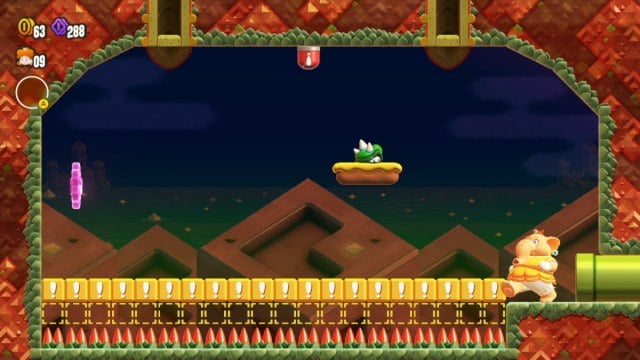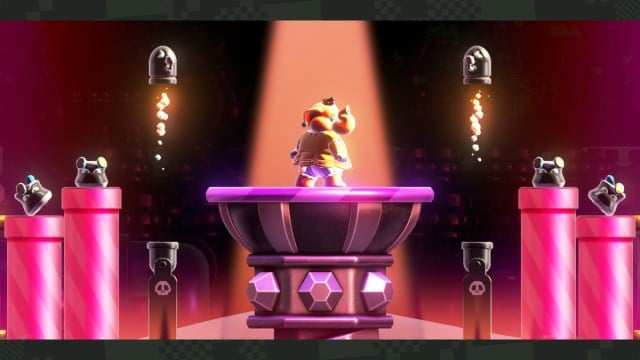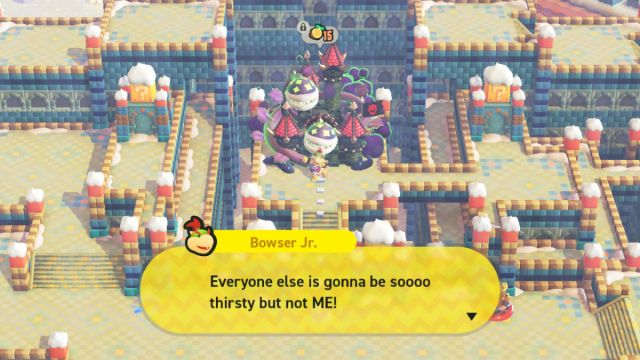Everyone knows what to expect from Super Mario games: stomp on the Goomba. Jump over the Piranha Plant. Travel in the Warp Pipe. When do you instead get to travel on top of the Warp Pipe, listen to the Piranha Plants sing, and become a Goomba? Super Mario Bros. Wonder is filled to the brim with the unexpected, each level delivering refreshing twists on tradition. But the game also gives players a fine-tuned sense of control over their adventure, perfectly balancing player expectations with spectacle and surprise.
Super Mario Bros. Wonder sends Mario and friends across the Flower Kingdom, where stages have the traditional Goal Poles, power-ups, and tight platforming controls and challenges. Traversing through the Flower Kingdom is a treat when controls feel as responsive as they do: running, jumping, wall jumping, and even coming to a stop all feel precise, leaving players satisfied when they pull off a tricky feat and seeking improvement or alternate approaches when they fail. Lives aren’t so plentiful as to completely negate the stakes of losing, but there are always just enough to give players a sense of security to try, try again when the going gets tough.
Of course, another option is to forego the stage entirely if it’s proving particularly tough, a wonderful element of both freedom and control given to the player. Mario Wonder features six primary Worlds, a hub World with its own slew of stages, and an optional Special World with a collection of incredibly challenging levels. Players navigate these Worlds in a sometimes linear, sometimes open fashion. Certain stages are connected linearly ala Super Mario World, while some exist in an open area that players can freely run and jump around in. Linear stages must be completed to progress to the next stage, such as completing Muncher Fields in the hub world to open up the area that leads to World 6. All the while, completing stages in the open area is entirely up to the player’s discretion.
This is used to particularly fun effect in Worlds like W4 Sunbaked Desert, where some stages are invisible until you approach them, and others are hidden away behind a trick wall. Besides, out-of-the-way stages, Worlds also have hidden Warp Pipes that lead to secluded areas where Captain Toad gifts players extra Flower Coins. With their own special secrets to discover, players are encouraged to search through the overworld with a fine-toothed comb, treating it much like a stage of its own.
The number of Wonder Seeds players need to unlock the World’s remaining stages are helpfully displayed not only on the stages themselves, but in the top left corner of the screen. There’s never any question about how close someone is to unlocking a new area within the current World. Completionists can dismiss this information entirely and work on maxing out their collection, while anyone who wants to breeze through to the end credits can easily keep track of when they’re ready to move on, no matter where their character is positioned in the World.
In addition to standard platforming stages, Mario Wonder features an impressive breadth of stage types to appeal to a variety of players: KO Arena stages pit the player against a hoard of enemies that they must defeat in a certain amount of time. Search Party stages are elaborate puzzles where players have to figure out where five Wonder Tokens are hiding. Break Time! stages offer relaxing, low-stakes activities that still result in a Wonder Seed when completed. Wiggler Race stages are exactly what they sound like: fun and fast races against a Wiggler in roller skates. Badge Challenge stages have players complete a stage while wearing a particular badge. Players can pick and choose the stage types they’re most comfortable with as they progress through the Flower Kingdom, although Badge Challenge stages are especially worthwhile to prioritize since completing them rewards players with not only a Wonder Seed, but the badge itself if they don’t have it already.
Badges, Bursting with Abilities

Players can choose one of 12 Mario series characters to play as, including two Toads and four Yoshis of varying colors. Unlike some other games where each character has their own gameplay quirk, everyone in Mario Wonder plays the same as each other. The sole exceptions are the Yoshis and Nabbit, who are unaffected by power-ups but, in return, don’t take any damage. This allows players to choose who they like and let their platforming skills do the talking. Tweaks to gameplay instead come from the game’s badges.
Badges in Mario Wonder are phenomenal accessories that alter the way the player’s character behaves or change elements of the stage itself. These play a major role in the difficulty of the game overall, and allow players to further curate their platforming experience as they see fit. Some badges enhance movement, such as the Dolphin Kick badge, which allows players to swim faster underwater, or the Floating High Jump badge, which gives players a higher jump with some floating before dropping down.
Other badges alter difficulty more generally. One such badge that players earn very early on is the Add ! Blocks badge. As the name suggests, wearing this badge adds extra ! Blocks to the stage. These blocks can serve as additional platforms to make certain jumps easier, barriers to protect players from pesky enemies like Thwomps, or even as special blocks housing power-ups.
Anyone needing extra assistance can choose the badge that best fits their needs at the start of each stage, such as using the Safety Bounce badge to survive levels with deadly lava. Players may also choose their badge to align with a preferred playstyle, such as choosing the Fast Dash badge if faster running is an appealing prospect. Best of all, if a player fails partway through a stage, they can re-select a badge before respawning at the checkpoint. This is especially helpful if the upcoming segment of the stage is notably different from the prior segment, or in a palace level before a boss fight, where badges such as the Add ! Blocks badge don’t have much, if any, effect.
The Marvelous Wonder Flower

The biggest stars of the Mario Wonder show, and the feature that has the largest effect on the game overall, are its Wonder Flowers. Each main platforming stage has a Wonder Flower to find, and activating it turns stages completely on their head—or turns the player into a Goomba. Or a slime.
Players never know what to expect when touching a Wonder Flower (except that completing the Wonder Flower segments reveals a Wonder Seed to collect), adding all manner of surprises to an already exciting adventure. When players become a Goomba, the game shifts into stealth survival mode, as players hide behind trees to avoid being eaten by a Maw-Maw. Other times, players may be tossed onto the stage’s normally inaccessible upper platforms, changing the game’s perspective from sidescrolling to top-down. Sometimes players may have to expertly jump over and duck under obstacles while they ride atop a raging stampede of Bulrushes. With 69 platforming levels with Wonder Flowers, the possibilities truly feel endless, even when some gimmicks overlap, such as turning into a slime with the ability to stick to any surface.
Although certain stages feature their Wonder Flowers prominently, others have them hidden out of the way. Talking Flowers offer commentary in almost every stage and will point out when players are “missing something.”
Sometimes, there are secrets without secrets, such as in the first very stage, where a hidden area can be found by not activating the Wonder Flower. And with tiny exception, it’s possible to finish a stage without touching its Wonder Flower at all. If a Wonder Flower segment feels too tough to complete, there’s no shame in skipping it for now—players will simply need to find extra Wonder Seeds to progress to the end of the World elsewhere.
Coins for the Completionist
Mario Wonder strikes a careful balance between what players can carry over between Worlds. Although Wonder Seeds are used to unlock stages, only Seeds from that same World count towards those totals. Players can’t “stock up” on Wonder Seeds from earlier Worlds to skip through later ones, ensuring that each World gets its due. This also helps when players find a particular World challenging—they won’t have to “double down” in a later world to make up for getting by with the absolute minimum number of Wonder Seeds earlier.
What players can carry between Worlds are purple Flower Coins. Almost every stage has three large, 10-value Flower Coins that count towards its max completion. Like the Wonder Flower gimmicks and secret exits, 10-value Flower Coins are hidden in all sorts of nooks and crannies that encourage players to tread carefully, retread ground, and to play around with different badges and power-ups to find them all.
Flower Coins, big and small, can be used across any of the Worlds as players please. Sometimes, Poplins will need 50 Flower Coins to open a path leading to new stages. Each World also has at least one Poplin Shop, where players can buy various helpful items, including certain badges, 1-Up Mushrooms, and even Wonder Seeds. Each shop has one Wonder Seed to buy, which counts towards that World’s total. These Seeds give the completionist even more use for their Flower Coins, while they act as a helpful boost for the casual player.
Bowser Jr., the Boss Baby

The reason players are collecting these Wonder Seeds is to reach each World’s final stage to retrieve the Royal Seed. For most Worlds, the Royal Seed is housed in a palace stage with a boss fight against Bowser Jr. at the end. Bowser Jr. utilizes Wonder Power just enough to make each fight distinct, including one battle with constantly alternating platforms, and another with water that sometimes obeys and other times disobeys the laws of gravity. Although inoffensive, these Wonder Powers aren’t nearly as exciting as those displayed across the stages. It’s not to say that the Mario series doesn’t pull off impressive boss battles, but the focus in Mario Wonder is the platforming, and that’s where the Wonder Power shines its brightest.
This includes the palace stages leading up to the Bowser Jr. boss battles, which boast their own platforming challenges and unique Wonder Flower gimmicks. In that vein, not every World in Mario Wonder ends with a boss battle: both Worlds 3 and 5 end with pure platforming stages with no boss battle in sight. While Bowser Jr. himself may not boast the variety Mario Wonder otherwise provides, the levels he inhabits do. It’s a very good sign when the weakest aspect of the game is that his occasional fights could have felt more diverse.
The final battle with Bowser also feels simple, but is conceptually fun, requiring careful timing and increasing precision as the fight goes on. Set on a literal stage, the battle makes great use of spectacle, built up from the levels prior. It’s a final boss battle that’s fun and accessible in difficulty for anyone, leaving the hardest challenges—100% completion, Special World stages, and badge collection—scattered across the game for those brave enough to tackle them.
Absolutely Wonderful

Super Mario games tend to be marvelous in their own ways. From the vibes of Super Mario Sunshine to the majesty of Super Mario Galaxy, from the innovation of Super Mario World to the scope of Super Mario Odyssey, it’s hardly fair to claim that every Mario game is exactly the same as each other. Despite this, Super Mario Bros. Wonder manages to stand out from the crowd through its creative Wonder Flower segments, outstanding options for innate difficulty curation, and sheer number of diverse stages. For longtime fans, there’s something new and exciting to discover around every corner. For new players, there’s a welcoming and spectacular adventure filled with joy and whimsy. Each moment and every facet of Super Mario Bros. Wonder is, as the name suggests, absolutely wonderful.

- Tight, responsive controls.
- A wide variety of stage types and badges offer completely controllable difficulty.
- Unique and enjoyable Wonder Flower gimmicks.
- The same Wonder Flower variety isn't present in Bowser Jr. boss battles.





Published: Nov 3, 2023 03:34 pm